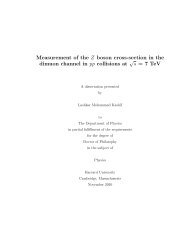2 The CDF Experiment at Fermilab Contents - Harvard University ...
2 The CDF Experiment at Fermilab Contents - Harvard University ...
2 The CDF Experiment at Fermilab Contents - Harvard University ...
You also want an ePaper? Increase the reach of your titles
YUMPU automatically turns print PDFs into web optimized ePapers that Google loves.
Section 2: Run II Triggers 85<br />
for b-tags. <strong>The</strong> B group plans to make use of leptons with p T as low as 2 GeV/c. <strong>The</strong><br />
leptonic inform<strong>at</strong>ion is used <strong>at</strong> Level 1, which only reduces the r<strong>at</strong>e compared to our<br />
`default' (SVT-based) tagging option. At the Level 2, due to B meson semileptonic<br />
branching fractions, the lepton trigger is comparable to a trigger based on displaced<br />
tracks from SVT. <strong>The</strong> missing bit of inform<strong>at</strong>ion is the eect of the muon fakes and<br />
electron conversions (the inner detector has more m<strong>at</strong>ter in Run II, and the conversion<br />
r<strong>at</strong>e is expected to increase compared to Run I d<strong>at</strong>a). Student David Medvigy is also<br />
involved in this study.<br />
We envision a combined SVT-based and lepton-based trigger, th<strong>at</strong> uses the lepton info<br />
<strong>at</strong> Level 1 if it is available, and then meshes the leptonic and displaced-track tags <strong>at</strong><br />
Level 2. We plan to set the cuts on displacement(jd 0 j) and lepton p T so th<strong>at</strong> they are<br />
almost interchangeable, and in th<strong>at</strong> way dene one d<strong>at</strong>aset comprising of SVT-SVT,<br />
SVT-lepton and lepton-lepton b-tags.<br />
3. b-tagging algorithms <strong>at</strong> Level 3: our current work is based on two SECVTX tags<br />
<strong>at</strong> Level 3. However, we consider SECVTX to be `destructive', in a sense th<strong>at</strong> it has<br />
high purity <strong>at</strong> the expense of signal eciency. We would prefer to use an algorithm<br />
more ecient for the H + W=Z signal <strong>at</strong> Level 3, allowing for more maneuvering room<br />
oine.<br />
4. b-jet mass resolution: the di-jet mass resolution is crucial for the sensitivity to higgs<br />
signals. As discussed in the next section, advances there will improve the performance<br />
of this trigger, too.<br />
5. Oine analysis: <strong>The</strong>re are two levels of involvement:<br />
(a) Use existing Run I code and SECVTX tagging to upd<strong>at</strong>e the Run I limit in the<br />
light of the change in the trigger.<br />
(b) Upd<strong>at</strong>e the limit using the Run II software tools. This would also prepare us for<br />
the Run II d<strong>at</strong>a, and may feed back into the Level 3 b-tagging algorithms, which<br />
will also be based on the Run II software tools.<br />
In conclusion, although there are several technical issues th<strong>at</strong> still remain to be settled,<br />
we have veried th<strong>at</strong> the fundamental ideas behind this trigger are sound, and th<strong>at</strong> such a<br />
trigger is viable in Run II.















